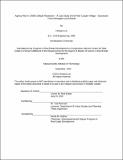| dc.contributor.advisor | W. Tod McGrath. | en_US |
| dc.contributor.author | Lai, Hengwa | en_US |
| dc.contributor.other | Massachusetts Institute of Technology. Center for Real Estate. Program in Real Estate Development. | en_US |
| dc.date.accessioned | 2011-04-04T16:18:42Z | |
| dc.date.available | 2011-04-04T16:18:42Z | |
| dc.date.copyright | 2010 | en_US |
| dc.date.issued | 2010 | en_US |
| dc.identifier.uri | http://hdl.handle.net/1721.1/62055 | |
| dc.description | Thesis (S.M. in Real Estate Development)--Massachusetts Institute of Technology, Program in Real Estate Development in Conjunction with the Center for Real Estate , 2010. | en_US |
| dc.description | Cataloged from PDF version of thesis. | en_US |
| dc.description | Includes bibliographical references (p. 54-56). | en_US |
| dc.description.abstract | Between 2010 and 2018, approximately $410 billion of maturing CMBS loans are expected not to able to refinance; that is, they are in high risk of default. The current real estate downturn has not only pushed delinquencies to a historic high but has also inflicted losses to bondholders. When losses are realized through foreclosure, junior bondholders can have the face amount of their investment significantly reduced with no cash payment, while the senior bondholders receive partial repayment of their investment at par. Alternatively, loan modifications, or workouts, yield different outcomes which are more favorable to the junior bondholders. The rising tide of loan defaults and loan workouts will certainly exacerbate the ongoing "tranche war" among the CMBS bondholders. Consequently, it is imperative to understand how the CMBS servicing structure governs default resolution and loan workouts. By analyzing the recent default of Peter Cooper Village-Stuyvesant Town, this study will examine the case of the largest commercial real estate default in the US history as a real life example to illustrate whether the overlapping role of B-Piece buyer and Special Servicer adversely affects workout prudence. Through interviews with industry professionals and a review of the Pooling and Servicing Agreement (PSA), and a review of the transcript of the CMBS Investment Grade Bondholder Forum in June, 2010, the study proposes structural changes that could potentially mitigate agency risk inherent in the current servicing structure.. | en_US |
| dc.description.statementofresponsibility | by Hengwa Lai. | en_US |
| dc.format.extent | 56 p. | en_US |
| dc.language.iso | eng | en_US |
| dc.publisher | Massachusetts Institute of Technology | en_US |
| dc.rights | M.I.T. theses are protected by
copyright. They may be viewed from this source for any purpose, but
reproduction or distribution in any format is prohibited without written
permission. See provided URL for inquiries about permission. | en_US |
| dc.rights.uri | http://dspace.mit.edu/handle/1721.1/7582 | en_US |
| dc.subject | Center for Real Estate. Program in Real Estate Development. | en_US |
| dc.title | Agency risk in CMBS default resolution : a case study of the Peter Cooper Village - Stuyvesant Town mortgage loan default | en_US |
| dc.title.alternative | Agency risk in Commercial Mortgage Backed Securities default resolution : a case study of the Peter Cooper Village - Stuyvesant Town mortgage loan default | en_US |
| dc.type | Thesis | en_US |
| dc.description.degree | S.M.in Real Estate Development | en_US |
| dc.contributor.department | Massachusetts Institute of Technology. Center for Real Estate. Program in Real Estate Development. | en_US |
| dc.contributor.department | Massachusetts Institute of Technology. Center for Real Estate | |
| dc.identifier.oclc | 707932534 | en_US |
